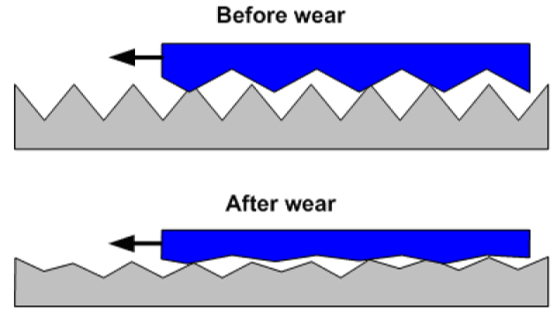Sliding abrasive wear is an important failure mechanism for plastics components, and is the result of movement of the asperities on the surfaces over one another. Two-body wear occurs when the asperities (surface roughness, peaks) of one surface (usually harder than the second) cuts into and removes material from the opposite surface.

Wear is the direct result of the same processes that causes friction – the movement of the asperities on the surfaces over one another.
Plastics used for sliding wear applications are most often in direct rubbing contact with metal components. The plastic, being softer, generally wears faster with significant material loss. One approach to reduce wear is the incorporation of polytetrafluoroethylene (PTFE) into the plastic. Particulate PTFE is compound into many different types of thermoplastics at a loading of 5% to 20%, dispersed homogeneously. In general, PTFE has very good friction and wear performance in applications that involve sliding contact. Compounding PTFE into thermoplastics gives these materials improved wear resistance. Improvements in coefficient of friction up to 60% can be achieved, depending on the base resin. This is accompanied by reduction in wear resistance up to 90%, again depending on the base polymer.
The mechanism for this drastic improvement is initiated by the wear of the surface of the plastic. This exposes the PTFE particles, which subsequently smear under the action of the sliding contact. This produces a smooth, low friction protective lubricating interface on the plastic. In cases where the mating surface is metal, some of the PTFE is deposited onto the metal surface filling in the asperities.

It should be noted that while the addition of PTFE reduces the system friction and improves the wear resistance, this often comes at the expense of mechanical properties. Comparatively, the addition of PTFE will typically decrease tensile strength and modulus, and result in a reduction in the impact resistance. Additionally, the PTFE will significantly increase the density of the compounded material, increasing part weight and part cost.
To see more about the analysis of plastic parts for the presence of polytetrafluoroethylene (PTFE) additives, check out this post: Analysis of PTFE Internal Lubricant
